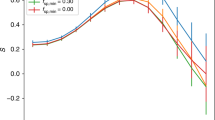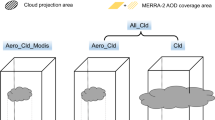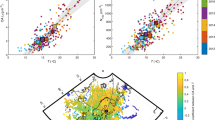Abstract
Anthropogenic aerosols enhance cloud reflectivity by increasing the number concentration of cloud droplets, leading to a cooling effect on climate that is referred to as the Twomey effect1,2. Here we show that anthropogenic aerosols exert an additional effect on cloud properties that is derived from changes in the spectral shape of the size distribution of cloud droplets in polluted air and acts to diminish this cooling. This finding could help to improve our understanding of the indirect aerosol effect and its treatment in climate modelling.
This is a preview of subscription content, access via your institution
Access options
Subscribe to this journal
Receive 51 print issues and online access
$199.00 per year
only $3.90 per issue
Buy this article
- Purchase on Springer Link
- Instant access to full article PDF
Prices may be subject to local taxes which are calculated during checkout

Similar content being viewed by others
References
Twomey, S. Atmos. Environ. 8, 1251–1256 (1974).
Charlson, R. J. et al. Science 255, 423–430 (1992).
Liu, Y. & Daum, P. H. Geophys. Res. Lett. 27, 1903–1906 (2000).
Liu, Y. & Daum, P. H. Proc. 13th Int. Conf. On Clouds and Precipitation, Reno, USA 586–589 (2000).
Martin, G. M., Johnson, D. W. & Spice, A. J. Atmos. Sci. 51, 1823–1842 (1994).
Ackerman, A. S. et al. J. Atmos. Sci. 57, 2684–2695 (2000).
McFarquhar, G. M. & Heymsfield, A. J. J. Geophys. Res. D 106, 28675–28698 (2001).
Yum, S. S. & Hudson, J. G. Atmos. Res. 57, 81–104 (2001).
Hudson, J. G. & Yum, S. S. J. Atmos. Sci. 54, 2642–2654 (1997).
Noonkester, V. R. J. Atmos. Sci. 41, 829–845 (1984).
Hudson, J. G. & Yum, S. S. J. Atmos. Sci. 58, 915–926 (2001).
Garrett, T. J. & Hobbs, P. V. J. Atmos. Sci. 52, 2977–2984 (1995).
Hudson, J. G. & Li, H. J. Atmos. Sci. 52, 3031–3040 (1995).
Noone, K. J. et al. J. Atmos. Sci. 57, 2729–2747 (2000).
Noone, K. J. et al. J. Atmos. Sci. 57, 2748–2764 (2000).
Author information
Authors and Affiliations
Corresponding author
Ethics declarations
Competing interests
The authors declare no competing financial interests.
Rights and permissions
About this article
Cite this article
Liu, Y., Daum, P. Indirect warming effect from dispersion forcing. Nature 419, 580–581 (2002). https://doi.org/10.1038/419580a
Issue Date:
DOI: https://doi.org/10.1038/419580a
This article is cited by
-
In-situ observations reveal weak hygroscopicity in the Southern Tibetan Plateau: implications for aerosol activation and indirect effects
npj Climate and Atmospheric Science (2024)
-
Parameterization and Explicit Modeling of Cloud Microphysics: Approaches, Challenges, and Future Directions
Advances in Atmospheric Sciences (2023)
-
The Importance of the Shape Parameter in a Bulk Parameterization Scheme to the Evolution of the Cloud Droplet Spectrum during Condensation
Advances in Atmospheric Sciences (2023)
-
Anthropogenic sulfate aerosol pollution in South and East Asia induces increased summer precipitation over arid Central Asia
Communications Earth & Environment (2022)
-
Relationships between Cloud Droplet Spectral Relative Dispersion and Entrainment Rate and Their Impacting Factors
Advances in Atmospheric Sciences (2022)
Comments
By submitting a comment you agree to abide by our Terms and Community Guidelines. If you find something abusive or that does not comply with our terms or guidelines please flag it as inappropriate.



